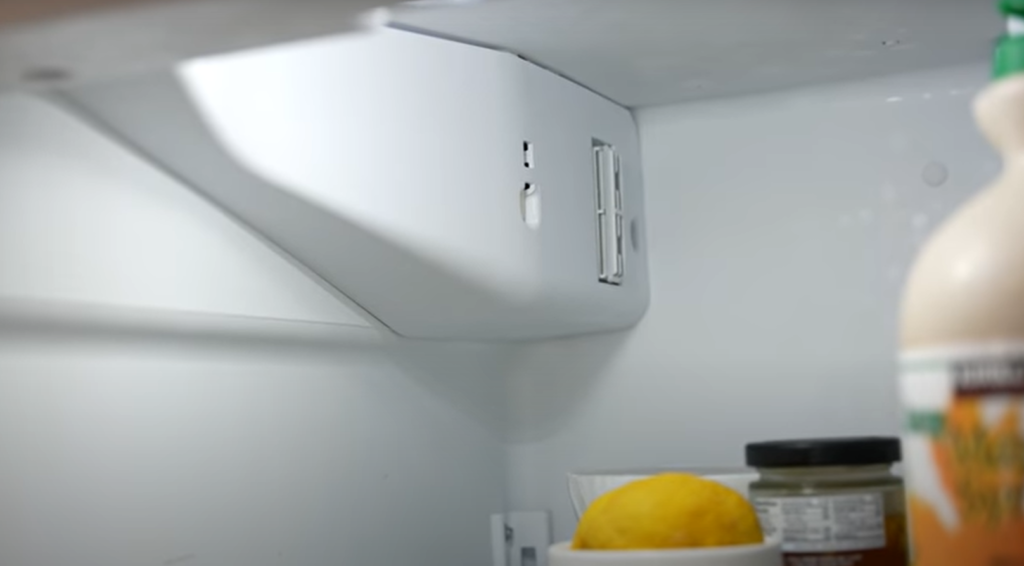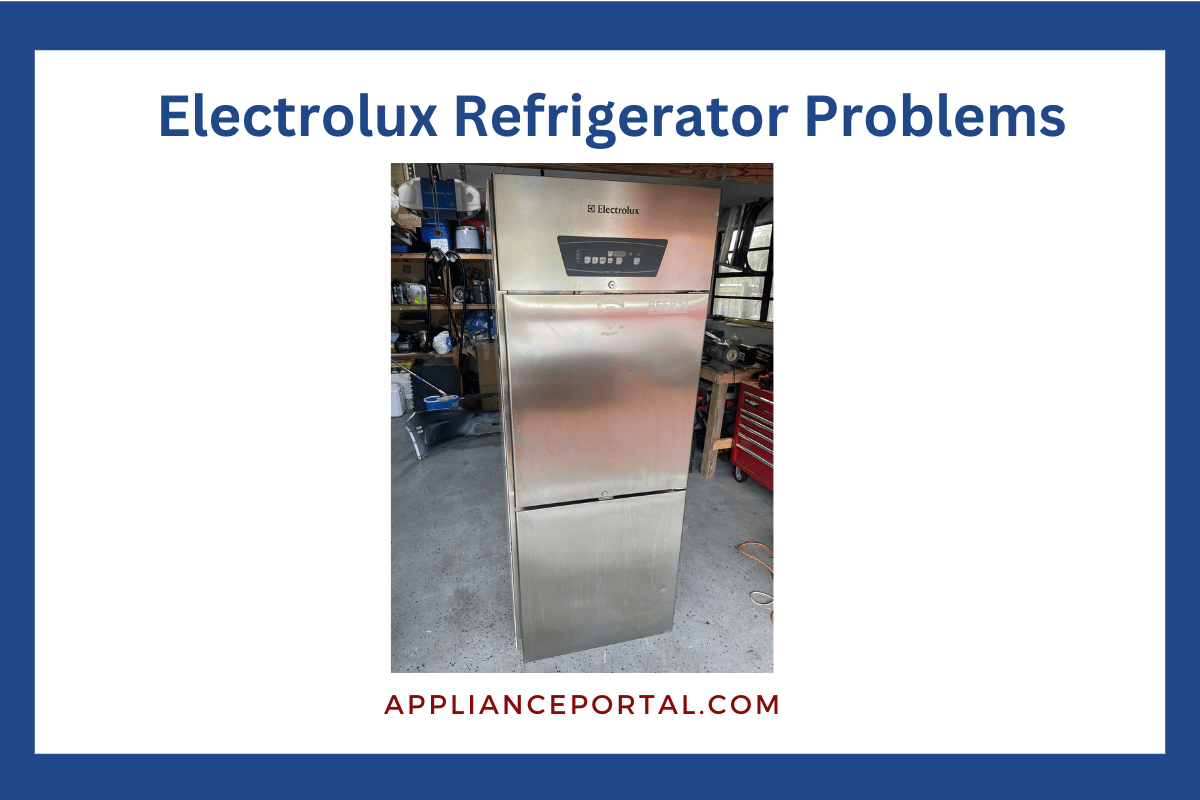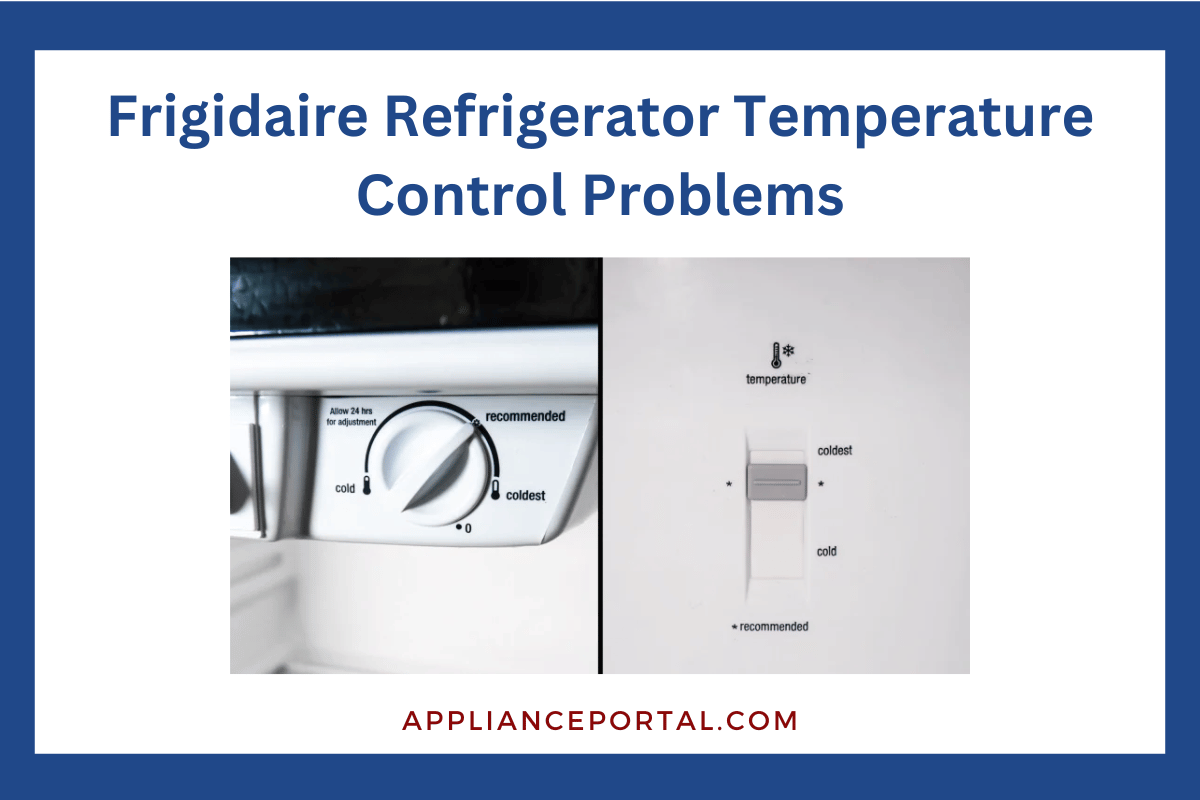If your Frigidaire refrigerator is not cooling, it could be due to several reasons such as a malfunctioning air damper, faulty thermistor, or a problem with the damper motor. To diagnose and fix the issue, you can try resetting the error code, checking the air damper, inspecting the freezer evaporator system, and testing the defrost heater and evaporator fan.
Additionally, you may need to clean the condenser coils and fan and replace any faulty parts like the relay, capacitor, or motor. Make sure to refer to your refrigerator’s manual or consult a professional for further assistance.
Common Causes Of Frigidaire Refrigerator Not Cooling
Experiencing a Frigidaire refrigerator not cooling can be due to several common causes like a faulty air damper, a malfunctioning control assembly, or a condenser motor issue. It is important to inspect these components and take appropriate measures for efficient cooling.
If you’re facing the frustrating issue of your Frigidaire refrigerator not cooling, there could be several common causes behind it. Let’s explore each of them below:
- Blocked airflow from the evaporator fan:
- The evaporator fan is responsible for maintaining proper airflow within the refrigerator. If it becomes blocked or stops working, it can lead to cooling problems.
- Check if there are any obstructions, such as food items or ice buildup, blocking the fan blades.
- Ensure that the fan motor is functioning correctly and replace it if necessary.
- Damaged or faulty condenser fan motor:
- The condenser fan motor helps dissipate heat from the refrigerator’s condenser coils. If it’s damaged or not working correctly, it can affect cooling efficiency.
- Inspect the fan motor for any signs of damage or malfunction, such as unusual noise or inability to spin.
- Replace the condenser fan motor if it is faulty to restore proper cooling.
- Malfunctioning thermostat:
- The thermostat regulates the temperature inside the refrigerator. If it malfunctions, it can prevent the refrigerator from cooling.
- Check if the temperature setting on the thermostat is accurate and adjust it if needed.
- If the thermostat is defective, consider replacing it to resolve the cooling issue.
- Dirty or blocked condenser coils:
- The condenser coils release heat from the refrigerator, allowing it to cool. If they are dirty or blocked, they can hinder the cooling process.
- Ensure that the condenser coils are clean and free from dust, debris, or pet hair.
- Use a vacuum cleaner or a coil brush to remove any accumulated dirt or debris from the coils.
Remember, addressing these common causes can help resolve the cooling problems in your Frigidaire refrigerator. However, if the issue persists, it’s advisable to consult a professional technician for further diagnosis and repair.

Credit: www.youtube.com
How To Identify Blocked Airflow From The Evaporator Fan
If your Frigidaire refrigerator is not cooling, one possible issue could be blocked airflow from the evaporator fan. To identify this problem, you can check for any obstructions near the fan or listen for any unusual noises coming from the fan.
Clearing any blockages or replacing a faulty fan can help restore proper cooling.
Signs Of Blocked Airflow:
- The refrigerator is not cooling properly.
- The freezer is working fine, but the fridge is warm.
- You notice a buildup of frost or ice on the evaporator coils.
- The fan in the freezer compartment is not running or is making strange noises.
Steps To Check And Clean The Evaporator Fan:
- Unplug the refrigerator and locate the evaporator fan. It is usually located behind the back panel in the freezer compartment.
- Remove any obstacles or food items that might be blocking access to the fan.
- Inspect the fan blades for any signs of damage or obstruction. If the blades are damaged, they may need to be replaced.
- With a soft brush or cloth, gently clean the fan blades and the area surrounding them. Be careful not to bend the blades or damage any other components.
- Plug in the refrigerator and check if the fan is running. It should be spinning smoothly and quietly.
- If the fan is still not working or making strange noises, it may need to be replaced. Contact a professional technician for further assistance.
- Once you have cleaned or replaced the evaporator fan, monitor the refrigerator’s temperature for a few hours to ensure that it is cooling properly.
Remember, if you are not comfortable or confident in cleaning or replacing the evaporator fan yourself, it’s always best to seek the help of a professional appliance technician.
Troubleshooting The Condenser Fan Motor
If your Frigidaire refrigerator is not cooling properly, troubleshooting the condenser fan motor may solve the issue. Check for any obstructions or damage to the fan motor and if necessary, replace it to restore proper cooling functionality.
Symptoms Of A Faulty Condenser Fan Motor:
- Refrigerator not cooling properly.
- Warm or hot air is being blown from the back of the refrigerator.
- Unusual noises coming from the back of the refrigerator.
- The condenser coils are dirty or clogged.
- The fan motor is not spinning or running at a slower speed.

Steps To Test And Replace The Condenser Fan Motor:
- Unplug the refrigerator: Ensure your safety by disconnecting the refrigerator from the power source before starting any maintenance or repair work.
- Locate the condenser fan motor: The condenser fan motor can usually be found at the back of the refrigerator, near the compressor and condenser coils. It is responsible for circulating air over the coils to cool them down.
- Check the fan blades: Inspect the fan blades for any damage, such as cracks or breaks. If the blades are damaged, it’s likely that the entire fan motor needs to be replaced.
- Test the fan motor: Use a multimeter to test the continuity of the condenser fan motor. If there is no continuity, it indicates a faulty motor that needs to be replaced.
- Check the fan motor for power: If the fan motor has continuity, but is not running, use a voltmeter to check if it is receiving power. If there is no power, the issue may be with the wiring or control board.
- Remove the fan motor: If the condenser fan motor needs to be replaced, carefully disconnect any electrical connections and remove the motor from its housing. Take note of any screws or clips that need to be removed.
- Purchase a new fan motor: Find the correct replacement motor for your specific refrigerator model. Ensure compatibility and purchase a high-quality replacement from a reliable source.
- Install the new fan motor: Place the new fan motor in the housing and reattach any screws or clips. Make sure all electrical connections are secure.
- Reassemble and test: Put the refrigerator back together, ensuring all components are properly reconnected. Plug the refrigerator back in and monitor its cooling performance. The refrigerator should now cool properly, with the condenser fan motor running smoothly.
- Regular maintenance: To prevent future issues, regularly clean the condenser coils and check the fan motor for any dirt or debris buildup. This will help ensure the efficiency of the condenser fan motor over time.
Remember, if you are not confident in your ability to troubleshoot or replace the condenser fan motor yourself, it is always recommended to seek professional assistance from a certified technician.
You may also like
Fixing A Malfunctioning Thermostat
Having trouble with your Frigidaire refrigerator not cooling? It could be a malfunctioning thermostat. Check out our blog post for step-by-step instructions on fixing the issue and getting your fridge back to its optimal cooling temperature.
Indications Of A Malfunctioning Thermostat:
- The refrigerator is not cooling properly.
- The temperature inside the refrigerator is too warm, even when set to the coldest setting.
- The temperature inside the refrigerator fluctuates frequently.
- The refrigerator runs continuously without turning off.
- The refrigerator is freezing food in the fresh food section.
Steps To Test And Replace The Thermostat:
- Check the power supply: Ensure that the refrigerator is properly connected to a power source and that the circuit breaker hasn’t tripped.
- Locate the thermostat: Typically, the thermostat is located behind the control panel or inside the fridge compartment.
- Disconnect the power: To avoid electrical shock, unplug the refrigerator or turn off its power supply.
- Remove the control panel or cover: Depending on the model, you may need to unscrew or detach the control panel or cover to access the thermostat.
- Test the thermostat: Use a multimeter set to the ohms (Ω) function to test the thermostat. Place one probe on each terminal of the thermostat and check for continuity. If there is no continuity, the thermostat is malfunctioning and needs to be replaced.
- Replace the thermostat: If the thermostat fails the test, disconnect the wiring connected to the thermostat terminals. Remove any screws or clips holding the thermostat in place, and take out the old thermostat. Install the new thermostat, securing it with screws or clips, and reconnect the wiring.
- Reattach the control panel or cover: Put the control panel or cover back in place and secure it with screws or clips.
- Restore power: Plug in the refrigerator or turn on its power supply.
- Test the refrigerator: Set the desired temperature on the thermostat and wait for a few hours to ensure that the refrigerator is cooling properly.
- Monitor the refrigerator: Keep an eye on the refrigerator’s temperature over the next few days to ensure that the new thermostat is functioning correctly. If the cooling problem persists, consider contacting a professional appliance repair technician.
Remember, if you’re unsure about testing or replacing the thermostat yourself, it’s always best to consult a professional technician to avoid any further damage to your refrigerator.
Cleaning Dirty Or Blocked Condenser Coils
If your Frigidaire refrigerator is not cooling properly, it could be due to dirty or blocked condenser coils. Cleaning these coils can help improve cooling efficiency and restore proper function to your refrigerator.
Importance Of Clean Condenser Coils:
- Clean condenser coils are essential for the efficient cooling performance of your Frigidaire refrigerator.
- Dirty or blocked condenser coils can restrict airflow and cause your refrigerator to work harder to cool, resulting in higher energy consumption.
- Regularly cleaning the condenser coils can extend the lifespan of your refrigerator and save you money on energy bills.
Methods To Clean Condenser Coils Effectively:
- Turn off the refrigerator and unplug it from the power source to ensure safety.
- Locate the condenser coils, typically located at the back of the refrigerator or underneath it.
- Use a soft brush or vacuum cleaner with a brush attachment to gently remove dust and debris from the coils.
- Be careful not to damage the coils while cleaning, as this can affect the cooling efficiency of the refrigerator.
- If the coils are heavily soiled, you can use a coil cleaning brush or special coil cleaning solution to thoroughly clean them.
- Ensure that all dirt and grime is removed from the coils before plugging the refrigerator back in.
- Once the coils are clean, plug the refrigerator back in and turn it on to check if the cooling performance has improved.
Remember, cleaning the condenser coils should be done regularly to maintain the optimal cooling performance of your Frigidaire refrigerator.
Additional Tips And Considerations
If you are experiencing issues with your Frigidaire refrigerator not cooling, there are some additional tips and considerations to keep in mind. These can include checking the air damper, inspecting the freezer evaporator system, and cleaning the coils. By following these steps, you may be able to troubleshoot and resolve the cooling issue with your refrigerator.
Proper Refrigerator Maintenance:
- Clean the condenser coils: Dust and debris can accumulate on the condenser coils, causing the refrigerator to work harder and not cool efficiently. Use a vacuum or a coil brush to remove the buildup regularly.
- Check the door seals: Damaged or worn-out door seals can let warm air enter the fridge, causing it to not cool properly. Inspect the seals for any cracks or gaps and replace them if necessary.
- Maintain proper airflow: Make sure there’s enough space around the refrigerator for proper airflow. Avoid overcrowding the fridge and ensure that the vents are not blocked by items.
- Keep the temperature settings correct: Check and adjust the temperature settings to ensure they are set correctly for optimal cooling. The recommended temperature for the refrigerator is between 35 and 38 degrees Fahrenheit.
- Avoid overloading the fridge: Overloading the refrigerator with too many items can block the airflow and prevent proper cooling. Organize the fridge to allow for adequate airflow.
When To Seek Professional Help:
- Persistent cooling issues: If the refrigerator continues to have cooling problems even after troubleshooting, it may require professional assistance. A technician can diagnose and fix complex issues that you may not be able to handle on your own.
- Frequent breakdowns: If your Frigidaire refrigerator frequently breaks down or experiences multiple cooling issues, it’s a sign that a professional assessment is necessary. They can identify the root cause of these recurring problems and provide a long-term solution.
- Strange noises or odors: Unusual noises or unpleasant odors coming from the refrigerator may indicate underlying issues. Professional help can identify and rectify the problem before it worsens.
- Fridge is not under warranty: If your Frigidaire refrigerator is no longer covered by the manufacturer’s warranty, it’s advisable to seek professional help to avoid any further damage that may void the warranty.
- Lack of technical knowledge: If you do not have the necessary technical knowledge or experience to troubleshoot and repair refrigerators, it’s best to leave it to the experts. They have the skills and expertise to handle complex refrigeration issues.
Remember, regular maintenance and timely professional assistance can ensure your Frigidaire refrigerator functions optimally and keeps your food fresh for longer.
Frequently Asked Questions For Frigidaire Refrigerator Not Cooling
Why Is My Frigidaire Refrigerator Not Getting Cold?
Possible reasons why your Frigidaire refrigerator is not getting cold include a clogged air filter, a malfunctioning thermostat, or a faulty start relay.
Why Is My Frigidaire Refrigerator Not Cooling But The Freezer Works?
A Frigidaire refrigerator may not cool but the freezer works due to a clogged air filter, faulty thermostat, or a damaged evaporator fan motor.
How Do I Reset My Frigidaire Refrigerator?
To reset your Frigidaire refrigerator, you can try these steps: 1. Unplug the refrigerator from the power source for about 5 minutes. 2. Plug the refrigerator back in and wait for it to start up. 3. Set the temperature control to the desired setting.
4. Allow the refrigerator some time to cool and check if it’s working properly. Note: If the issue persists, it’s recommended to contact Frigidaire customer support for further assistance.
What Does It Mean When Fridge Is Running But Not Cooling?
If your fridge is running but not cooling, it could be due to a clogged air filter, a malfunctioning thermostat, or a faulty start.
Conclusion
If you’ve noticed that your Frigidaire refrigerator is not cooling properly, it’s important to address the issue as soon as possible. Ignoring a cooling problem can lead to spoiled food and potentially costly repairs down the line. There are several reasons why your Frigidaire refrigerator may not be cooling effectively.
It could be due to a clogged air filter, a malfunctioning thermostat, or a faulty start relay. Regular maintenance, such as cleaning the condenser coils and ensuring proper airflow, can also help prevent cooling issues. Before calling a professional for help, try troubleshooting the problem yourself.
Check the air filter and clean or replace it if necessary. Verify that the thermostat is set to the correct temperature and adjust as needed. Additionally, inspect the start relay for any signs of damage or malfunction. If these steps don’t resolve the cooling issue, it’s time to seek professional assistance.
A qualified technician can diagnose and repair the problem efficiently. Remember to choose a reputable and experienced technician to ensure a thorough and effective solution. Don’t let a cooling problem ruin your Frigidaire refrigerator, take action and restore it to its optimal functionality.





Leave a Reply